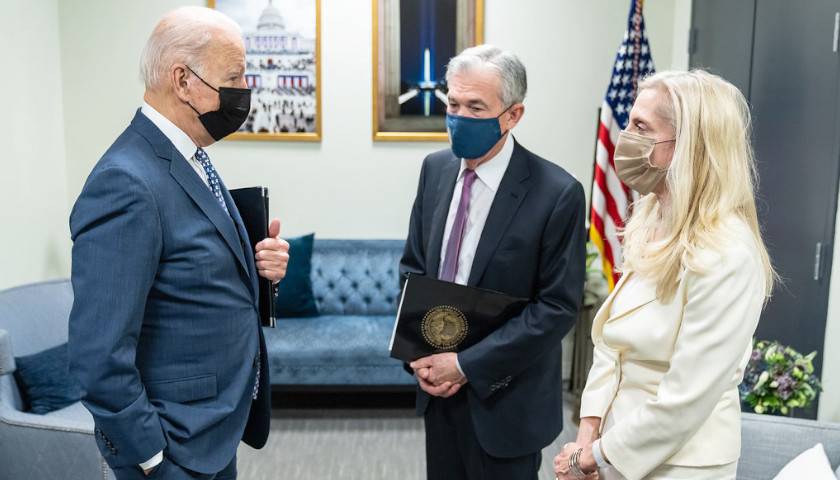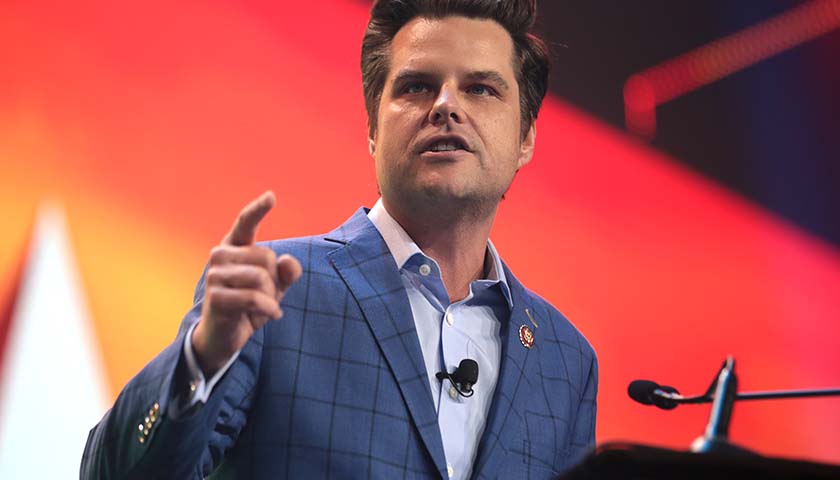by Pete McGinnis
In February 2021, Federal Reserve Chairman Jerome Powell told Congress, “We are not climate policymakers here who can decide the way climate change will be addressed by the United States. We’re a regulatory agency that regulates a part of the economy.” When Powell said that, less than a month into the Biden administration, inflation was 1.6%.
Just eight months later, in remarks on November 22, 2021, President Biden said Powell – then up for renomination and facing stiff opposition from congressional progressives – “made clear to me: A top priority will be to accelerate the Fed’s effort to address and mitigate the risks – the risk that climate change poses to our financial system and our economy.” At that time inflation was 6.8%, on its way up to a 40-year high of 9.1%.
What changed? What caused Powell, a Republican originally appointed by President Trump, to go “freshly woke,” in Politico’s words? (Progressives had always thought him too conservative to steer the Fed in the direction they wanted). And why would President Biden renominate a Fed Chair who was so clearly failing at his core mission of controlling inflation?
The answer is all around us: “Bidenomics.” The White House has consistently proven – by word and deed – inflation is not a priority. If it were, the administration wouldn’t be pumping trillions of dollars into the economy while dismissing the economic harm Americans have experienced. The administration is interested in lavishing money on its interest groups and its priorities. One such priority is reorienting much of American economic policy toward addressing climate change.
They say that “personnel is policy.” In this case, policy became personnel. In internal emails and emails with the media, obtained from the Department of the Treasury via Freedom of Information Act request by the Functional Government Initiative (FGI), the administration appeared to be far more interested in climate change than Powell’s dismal record on inflation, even when considering whether to renominate Powell to the Fed Chair.
In the words of The Hill, Powell previously had “ruled out imposing climate-related bank stress tests similar to those in development in the U.K. and Europe. He has also refused to use the Fed’s immense power to steer funding away from fossil fuels and toward renewable energy, which many climate hawks consider essential to the fight against climate change.”
But that was then. Powell hadn’t forgotten his clear understanding of the Fed’s mission to serve as “the central bank of the United States to provide the nation with a safer, more flexible, and more stable monetary and financial system.” He just abandoned it as a condition of remaining in office.
Meanwhile, President Biden needed Powell to remain as Fed Chair because, with the Democrat majority in the senate so thin, the White House believed nobody to Powell’s left could be confirmed. But the Federal Reserve’s Board of Governors was a different story. It could be remade with more progressive members. According to Treasury emails, then-House Financial Services Committee Chair Maxine Waters had been demanding the Board be more diverse. So according to emails, a “package deal” was engineered, by which Powell would sign on to the administration’s climate change agenda, while changes would be made to the Board around him. Powell could be the face, but the body had to be sufficiently progressive.
One casualty would be Randal K. Quarles, a member of the Board of Governors, who was to resign and be replaced by a more progressive member. Meanwhile, Bidenomics staggered on. Fed policies bent toward dubious environmental concerns. The risk of recession lingers, and real average hourly earnings have declined more than 3% since January 2021. Inflation is twice as high as the Fed’s target of 2%, and nearly three times higher than it was when President Biden took office.
Powell recently told congress, “Inflation has consistently surprised us, and essentially all other forecasters, by being more persistent than expected and I think we’ve come to expect . . . it to be more persistent.” He also said, despite the official administration positivity, that the process of getting inflation back down to has a long way to go.” So, the Fed is planning to raise interest rates twice more in 2023.
The Biden administration prioritized climate change and the demands of progressive lawmakers over sound economics. It rendered an already failed Fed Chairman a figurehead unable to grapple with his fundamental responsibilities. When policy becomes personnel, you get Bidenomics.
– – –
Pete McGinnis is director of communications at the Functional Government Initiative.




